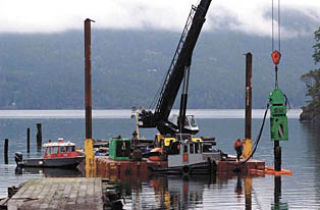When the San Juan County Land Bank, in partnership with The Trust for Public Land (TPL), purchased property at Judd Cove this fall, they acquired more than forested uplands, shoreline and tidelands.
The site of a historic lime kiln and, more recently, a dock and log-boom holding area, the acquisition also included remnants of those industrial activities in the form of over 80 creosote pilings.
Last week, the Department of Natural Resources (DNR) oversaw the removal of the aging dock and pilings, completing an important step towards restoring the cove’s ecology and preparing the nature preserve for public access.
Research has shown the compounds that make creosote an effective chemical to protect wood structures in the water are toxic to key fish species and carcinogenic to humans. The DNR, through its Aquatic Lands Program, is engaged in a large-scale creosote removal project as part of the Puget Sound Initiative. Their focus is on sites that are accessible to the public or are feeding areas for fish, especially forage fish, which in turn sustain seabirds, salmon and other Puget Sound species.
“The DNR’s ability to take on the creosote removal at Judd Cove has been invaluable,” explains Land Bank Director, Lincoln Bormann. “Without their participation, we may not have been able to move ahead with the acquisition.”
“We are pleased to partner with the San Juan County Land Bank on the clean-up efforts at Judd Cove,” adds commissioner of Public Lands, Doug Sutherland. “It’s another step in fostering a healthier Puget Sound.”
The Land Bank has owned property at Judd Cove since 2000. With the addition of this parcel, a total of 12 upland acres, 300 feet of shoreline and half of the cove’s tidelands are now protected. Over the coming months, the Land Bank will complete clean up and prepare for public access with the goal of opening the preserve by summer.
“We want to honor the ecology and history of the cove, address neighboring landowners concerns, and provide an experience that is safe for the public,” explains Ruthie Dougherty, the Land Bank’s Orcas Preserve Steward. “The process takes some time.”
Judd Cove offers a unique opportunity to conserve and restore valuable habitat and connect people to the shoreline and the island’s history. “This project is especially rewarding because it ensures that visitors can experience Judd Cove’s natural beauty, much as it was 100 years ago,” says Elizabeth Butler, Project Manager at The Trust for Public Land. “With many native critters and a long history of human uses, the cove provides a wonderful chance to learn about the natural resource industries that once flourished here, and nature’s resilience.”
For additional information, visit www.sjclandbank.org or call 378-4402.



